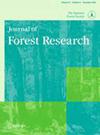Characterization and development of 14 microsatellite markers for mountain stewartia ( Stewartia ovata ): an uncommon, Appalachian-endemic member of the tea family
IF 1.1
4区 农林科学
Q3 FORESTRY
引用次数: 0
Abstract
ABSTRACTMountain stewartia [Stewartia ovata (Cav.) Weatherby] is a rare, endemic understory tree native to the southeastern U.S.A. While found only in microsites across southeastern Appalachia, the species distribution spans from northern Alabama and Georgia to southern Kentucky and Virginia. However, most occurrences have been recorded in Tennessee. While recent distribution surveys and habitat suitability modeling conducted for this species have improved our understanding of the environmental parameters that constitute its fundamental niche, the ecological profile of S. ovata remains poorly understood. Consequently, its rarity has raised concerns as to the long-term resilience of this species in the wild. Faced with these challenges, the assessment of existing genetic diversity in S. ovata through genetically informative molecular resources is critical to understanding the adaptive potential and ecological resilience of the species. Microsatellites are cost-efficient molecular tools capable of addressing these concerns by elucidating trends in population structure, population demography, and inbreeding. To increase the available genetic resources for S. ovata, we screened 105 microsatellite loci for their suitability to assess these population features using capillary gel electrophoresis. The utility of these markers was evaluated by assessing polymorphism information content (PIC) and population statistics, which yielded 14 highly polymorphic microsatellite markers. These markers displayed an average PIC of 0.695 (PIC range of 0.538–0.851), which supports their ability to capture fine-scale genetic diversity within the species. We also report a low average observed heterozygosity of 0.375 (versus an expected heterozygosity of 0.645) among screened loci, which reinforces the need for broader genetic diversity assessments within this species.Keywords: Mountain StewartiaStewartia ovatamicrosatellite markersAppalachian-endemic treeU.S. native tree Disclosure statementNo potential conflict of interest was reported by the author(s).Additional informationFundingThis work was supported, in part, by the United States Department of Agriculture (USDA; Grant 58‐6062‐6) and the University of Tennessee, Department of Entomology and Plant Pathology and the Office of Undergraduate Research. Partial funding and support for student efforts were provided by the USDA National Institute of Food and Agriculture Crop Protection and Pest Management (CPPM) Grant #13131957 and #7002511 (TEN00600) and #7004409 Hatch Projects (IPM and Sustainable Strategies for Arthropod Pests and Plant Diseases in Nurseries, Managed Landscapes and Urban Forests and Forest Health and Resilience, respectively). Special thanks to the University of Tennessee Open Publishing Support Fund for providing publication resources.阿巴拉契亚特有的茶科罕见植物山茶属(stewartia ovata)的14个微卫星标记的鉴定和开发
【摘要】山竹属植物[c .]是一种罕见的,美国东南部特有的林下植物,虽然只在阿巴拉契亚东南部的微型地点发现,但物种分布范围从阿拉巴马州北部和乔治亚州到肯塔基州南部和弗吉尼亚州。然而,大多数发生在田纳西州。虽然最近对该物种进行的分布调查和生境适宜性建模提高了我们对构成其基本生态位的环境参数的理解,但对该物种的生态概况仍然知之甚少。因此,它的稀缺性引起了人们对该物种在野外长期恢复能力的担忧。面对这些挑战,利用遗传信息性分子资源来评估卵形花现有的遗传多样性,对于了解该物种的适应潜力和生态恢复力至关重要。微型卫星是具有成本效益的分子工具,能够通过阐明人口结构、人口统计和近亲繁殖的趋势来解决这些问题。为了增加可利用的遗传资源,我们筛选了105个微卫星位点,利用毛细管凝胶电泳技术对它们的适宜性进行了评价。通过多态性信息含量(PIC)和群体统计分析,鉴定出14个高度多态性的微卫星标记。这些标记的平均PIC为0.695 (PIC范围为0.538 ~ 0.851),支持它们捕捉物种内精细尺度遗传多样性的能力。我们还报告了在筛选的位点中观察到的低平均杂合度为0.375(而预期杂合度为0.645),这加强了对该物种更广泛的遗传多样性评估的需求。关键词:山石竹;卵石竹;微卫星标记;披露声明作者未报告潜在的利益冲突。这项工作得到了美国农业部(USDA)的部分支持。Grant 58‐6062‐6)和田纳西大学昆虫学和植物病理学系以及本科研究办公室。美国农业部国家粮食和农业作物保护和病虫害管理研究所(CPPM)赠款#13131957和#7002511 (TEN00600)和#7004409孵化项目(分别为苗圃节肢动物病虫害的IPM和可持续战略,管理景观和城市森林以及森林健康和恢复力)提供了部分资金和支持。特别感谢田纳西大学开放出版支持基金提供的出版资源。
本文章由计算机程序翻译,如有差异,请以英文原文为准。
求助全文
约1分钟内获得全文
求助全文
来源期刊

Journal of Forest Research
农林科学-林学
CiteScore
3.00
自引率
6.70%
发文量
62
审稿时长
3 months
期刊介绍:
Journal of Forest Research publishes original articles, reviews, and short communications. It covers all aspects of forest research, both basic and applied, with the aim of encouraging international communication between scientists in different fields who share a common interest in forest science.
 求助内容:
求助内容: 应助结果提醒方式:
应助结果提醒方式:


